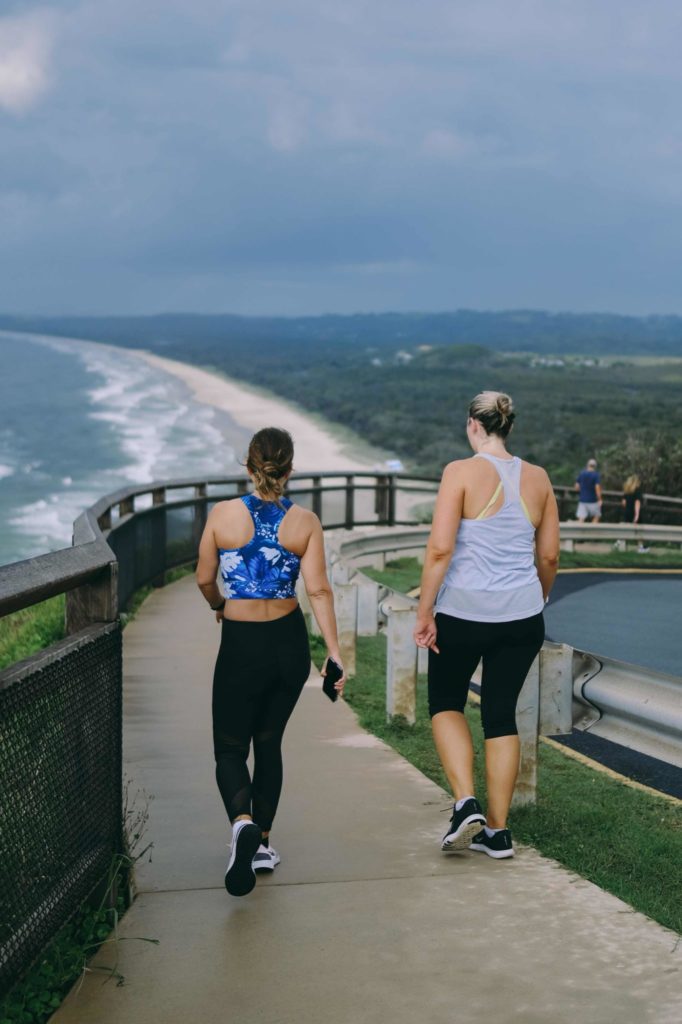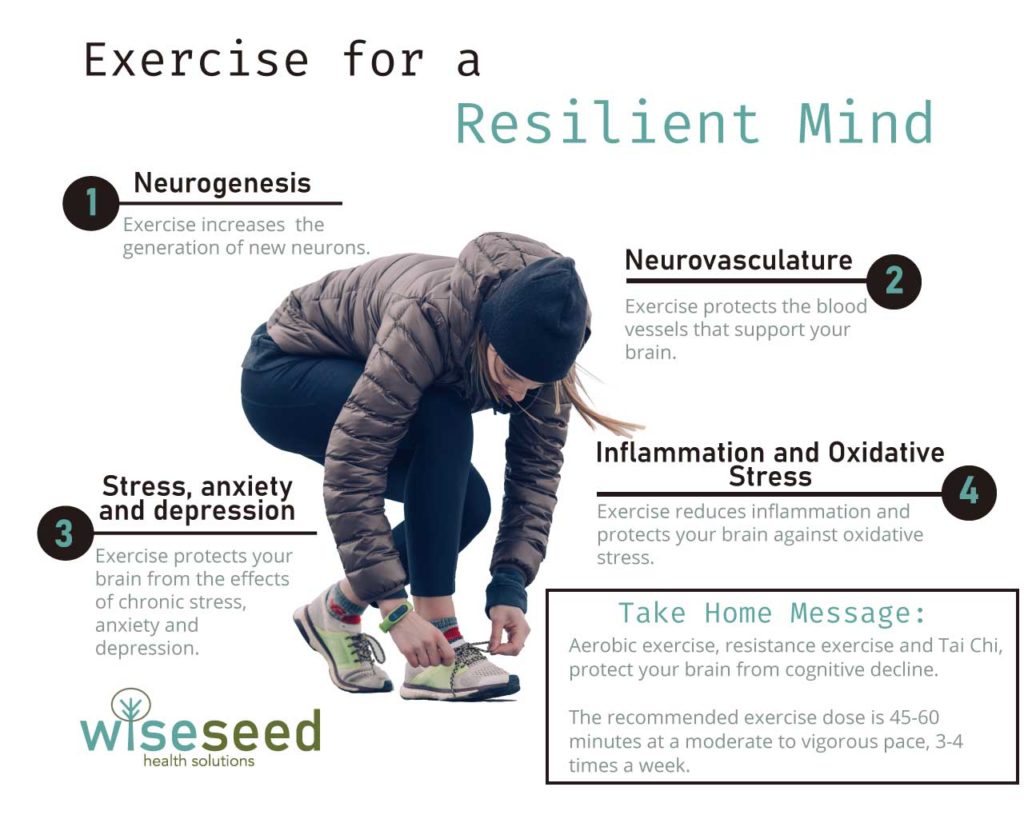Exercise for a Resilient Mind

The importance of maintaining a resilient mind
We believe that your mind is the most important of all your biological systems. After all, it is your mind that plans, executes, and experiences the joy of your success or the disappointment of your failure. It is your mind that falls in love, appreciates beauty, enjoys the company of friends, and treasures family.
It follows that to be a resilient human, you must have a resilient mind. Unfortunately, nature conspires to make your mind weaker. Your brain begins to decline in your late teens and continues to decline throughout adulthood (1). Hardest hit are the cognitive functions involved in learning new information and problem solving (1).
Here at Wise Seed we are committed to helping you become a more resilient human. In this article we explain how you can use exercise to help keep your brain healthy and your mind sharp.
The Aging Brain
Normal brain aging is characterized by an ongoing degradation of brain structure and function. As we have discussed previously, the degree of physical degradation of the brain can be measured using a combination of machine learning and modern brain imaging methods, to generate a score called BrainAge. Some of the key drivers of BrainAge are:
1. The reduced generation of new neuronal cells
2. Experiencing chronic stress, anxiety or depression
3. Blood vessel dysfunction and damage within the brain
4. Inflammation and oxidative stress
These four factors work together as you age to cause a loss of neurons, reduce your overall brain volume and increase brain microbleeds (2).
However, all is not lost. Studies have identified individuals whose BrainAge is significantly younger than their chronological age. Moreover, new research has shown some people retain a high level of cognitive function even into old age. Together, these observations show that it may be possible to delay or reduce age-related cognitive decline.
How does physical activity preserve brain function?
One of the greatest risk factors for cognitive decline and dementia are physical inactivity (3, 4). In contrast, being physically active throughout life and into old age protects you against the effects of cognitive decline and dementia (3, 4).
On this basis, exercise has been recommended as a powerful and cost-effective approach to delay or prevent cognitive decline (3, 4).However, this begs the question: How exactly does exercise protect your brain and keep your mind resilient?
1. Exercise increases the generation of new neurons
Neurogenesis is the generation of new neuronal cells from stem cells in the adult brain. These new neurons integrate into your neural circuitry to maintain your brain function over your lifespan. The hippocampus, a region of the brain that is involved in memory formation, undergoes significant levels of neurogenesis throughout adulthood in rodents, primates and humans (5).
It is clear from animal studies that exercise increases adult neurogenesis throughout life (6). Exercise releases a variety of hormones into the blood, which cross the blood brain barrier to trigger neurogenesis and improve cognitive function (6, 7).
Consistent with the studies performed in rodents, hippocampal volume increases in humans who regularly exercise (8, 9). Analysis of 14 independent studies found that a single aerobic exercise session increased circulating levels hormones that trigger neurogenesis (10). The magnitude of this effect was greater in those who exercised regularly in comparison to those who exercised infrequently (10). Importantly, there is a strong correlation with exercise and improved human cognitive function (10).

2. Exercise protects the blood vessels in your brain
The brain is dependent on a constant supply of blood due to its high metabolic demand (11). Blood vessels of the brain use autoregulation to ensure that a constant supply of nutrients reaches the neurons and their supporting cells (2). Both aerobic and resistance exercise improve blood vessel autoregulation (2). With resistance exercise, frequency rather than intensity was most strongly correlated with improvements in autoregulation, whereas higher intensity aerobic exercise resulted in the greatest improvements (2).
Because the brain requires continuous blood perfusion throughout the cardiac cycle, the brain vascular system has a much lower resistance than those of other organs (2). This makes the brain blood vessels particularly sensitive to the effects of pulse pressure. As we age, our major arteries stiffen, reducing their ability to buffer the changing blood pressure caused by your heartbeat. This in turn exposes the vulnerable brain blood vessels to the damaging effects of pulse pressure, which leads to micro-bleeds within the brain (11).
Exercise prevents brain micro-bleeds in two ways. First, long-term aerobic exercise reduces resting heart rate, which decreases the effects of pulse pressure. Second, older adults who regularly engage in physical exercise have lower central arterial stiffness, thereby preserving the buffering capacity of the thoracic arteries into old age (11).
3. Exercise protects against the effects of chronic stress, anxiety and depression
Chronic stress, anxiety and depression reduce cognitive function (2, 12), with depression in particular being a strong predictor of dementia in later life (12).
How does stress, anxiety and depression induce cognitive defects? In part because stress hormones such as cortisol readily cross the blood-brain barrier and enter the brain. Here they interact directly with neurons that are central to cognition (11). The intensity and duration of stress, anxiety or depression is the key variable that determines cognitive impairment. When the level of stress is high and/or chronically sustained, cognitive performance is noticeably impaired (11).
A meta-analysis of 49 studies revealed that exercise is associated with a reduction in anxiety across all age groups (11). The efficacy of exercise appears to be dose-dependent, with aerobic exercise of moderate-to-high intensity showing the most stress-busting effects (11). Exercise duration is also important, with exercise interventions of at least 15 weeks being the most effective intervention (11).
4. Exercise reduces inflammation
As we age our immune systems can become chronically activated in a syndrome known as sterile inflammation (13). Sterile inflammation increases two- to four-fold as we age, with increased inflammation is associated with many age-related diseases (13). Adults who show signs of chronic inflammation having greater risk of cognitive decline and dementia (14).
People who engage in high levels of physical activity consistently display lower inflammation than sedentary individuals (2). Resistance training, or a combination of resistance and aerobic training, have been used successfully lower inflammation in sedentary and obese adults (2).

5. Exercise protects you from oxidative stress
Mitochondria, known as the powerhouses of the cell, use oxygen to create energy that your cells can use. Alas, an unfortunate by-product of using oxygen to produce energy is the generation highly reactive free radicals. These free radicals react with and damage important molecules of the cell, such as proteins and DNA (15). Because most free radicals are generated in the mitochondria, the mitochondria themselves are particularly susceptible to free radical damage.
Free radical damage of the mitochondria and other cellular components has three negative effects on neurons. First, mitochondrial damage further increases in the production of free radicals. This creates a feedback loop, where the rate of free radical production is amplified over time. Second, damage reduces the ability of mitochondria to generate energy, which interferes with normal neuronal cell function and repair. Third, oxidative stress and damaged mitochondria increase inflammation in the brain. Chronic neuronal inflammation in turn increases oxidative stress and mitochondrial dysfunction, leading to more free radical production and triggering a viscous cycle of escalating damage to your brain.
Exercise protects your brain from oxidative stress in three ways:
1. Aerobic exercise increases mitochondrial synthesis and mitochondrial turnover. This dual effect is thought to increase the number of healthy mitochondria in brain cells while simultaneously removing the damaged mitochondria that contribute to oxidative stress and inflammation (16).
2. Physical activity upregulates antioxidant defence systems, which protect mitochondria and other cellular structures from free radical attack (17).
3. Exercise reduces neuroinflammation, which disrupts the viscous cycle between oxidative stress and inflammation in your brain (2).
How should you use exercise to prevent cognitive decline?
Exercise is beneficial for preserving cognitive function in older adults (18, 19), but what is the best exercise regime to preserve cognition?
Aerobic Exercise and Resistance Training

Both aerobic and resistance training have both been shown to improve human cognition (18, 19). Aerobic training has the strongest experimental support from animal models and human studies. However, resistance training also has positive effects on human cognition that are different and likely complementary to aerobic exercise (19). In fact, it is thought that combining aerobic and resistance training provides the optimal exercise intervention for preventing age-related cognitive decline (19).
The current recommendation for both aerobic and resistance training is that each workout should last between 45 minutes and one hour, performed 3-4 times per week. Your training intensity should be moderate to vigorous (19).
It’s important to keep in mind that many of the protective effects of physical exercise rely on physiological adaptation to exercise, such as a reduction in your resting heart rate. To ensure that this occurs, we recommend that you apply a progressive approach to both your aerobic and resistance training programs.
By this, we mean that you start at a reasonably easy level, then gradually increase intensity as your body adapts to the training load. In the context of aerobic training, this could mean gradually increasing the intensity, duration and frequency of your workouts as you get fitter. For resistance training, this means lifting heavier weights, performing more repetitions, or performing more sets per exercise as you get stronger and become conditioned to lifting.
Tai Chi
Evidence is emerging in support of Tai Ch as an exercise that can preserve cognitive function in older adults (19, 20). This is important, because Tai Chi offers an effective exercise regime that is accessible to individuals who may have difficulties performing aerobic and resistance training. Moreover, many people really like doing Tai Chi.
Current evidence suggests that Tai Chi should be performed for between 45 and 60 minutes, 3-4 times per week for optimal results (19).
Conclusion
Cognitive decline has long thought to be a normal part of the aging process. However, we argue that recent studies, which reveal older individuals with young brains or performing at an elite intellectual level, challenge this long-held paradigm.
For this reason, we believe that instead of focusing on how to live with cognitive decline, you should be directing some of your efforts towards avoiding it altogether. To help you achieve this goal, we present evidence supporting exercise as a safe and effective method to help mitigate the effects of aging on your brain.
Aerobic exercise, resistance training, Tai Chi, or a combination thereof; performed 3-4 times a week for 45 minutes to an hour at a moderate to vigorous intensity, has strong clinical support as an effective approach to reduce age-related cognitive decline.

References and Further Reading
1. T. Salthouse, Consequences of age-related cognitive declines. Annu Rev Psychol 63, 201-226 (2012).
2. G. Kennedy, R. J. Hardman, H. Macpherson, A. B. Scholey, A. Pipingas, How does exercise reduce the rate of age-associated cognitive decline? A review of potential mechanisms. Journal of Alzheimer’s Disease 55, 1-18 (2017).
3. G. Livingston et al., Dementia prevention, intervention, and care. The Lancet 390, 2673-2734 (2017).
4. T. Engeroff, T. Ingmann, W. Banzer, Physical activity throughout the adult life span and domain-specific cognitive function in old age: a systematic review of cross-sectional and longitudinal data. Sports Medicine 48, 1405-1436 (2018).
5. Kirsty l. Spalding et al., Dynamics of Hippocampal Neurogenesis in Adult Humans. Cell 153, 1219-1227 (2013).
6. M. W. Voss et al., Exercise and Hippocampal Memory Systems. Trends Cogn Sci 23, 318-333 (2019).
7. A. M. Horowitz et al., Blood factors transfer beneficial effects of exercise on neurogenesis and cognition to the aged brain. Science 369, 167-173 (2020).
8. F.-G. Pajonk et al., Hippocampal plasticity in response to exercise in schizophrenia. Archives of General Psychiatry 67, 133-143 (2010).
9. B. K. Pedersen, Physical activity and muscle-brain crosstalk. Nat Rev Endocrinol 15, 383-392 (2019).
10. G. G. de Assis, K. M. de Almondes, Exercise-dependent BDNF as a Modulatory Factor for the Executive Processing of Individuals in Course of Cognitive Decline. A Systematic Review. Front Psychol 8, 584-584 (2017).
11. A. Brunt, D. Albines, D. Hopkins-Rosseel, The effectiveness of exercise on cognitive performance in individuals with known vascular disease: a systematic review. Journal of Clinical Medicine 8, 294 (2019).
12. E. Zotcheva et al., Midlife physical activity, psychological distress, and dementia risk: The HUNT study. Journal of Alzheimer’s Disease 66, 825-833 (2018).
13. C. Franceschi et al., Inflammaging and anti-inflammaging: a systemic perspective on aging and longevity emerged from studies in humans. Mechanisms of Ageing and Development 128, 92-105 (2007).
14. B. Giunta et al., Inflammaging as a prodrome to Alzheimer’s disease. Journal of Neuroinflammation 5, 1-15 (2008).
15. J. Poddar, M. Pradhan, G. Ganguly, S. Chakrabarti, Biochemical deficits and cognitive decline in brain aging: Intervention by dietary supplements. J Chem Neuroanat 95, 70-80 (2019).
16. Z. Radak et al., Exercise effects on physiological function during aging. Free Radic Biol Med 132, 33-41 (2019).
17. M. Luca, A. Luca, Oxidative Stress-Related Endothelial Damage in Vascular Depression and Vascular Cognitive Impairment: Beneficial Effects of Aerobic Physical Exercise. Oxid Med Cell Longev 2019, 8067045-8067045 (2019).
18. S. Colcombe, A. F. Kramer, Fitness effects on the cognitive function of older adults: a meta-analytic study. Psychol Sci 14, 125-130 (2003).
19. J. M. Northey, N. Cherbuin, K. L. Pumpa, D. J. Smee, B. Rattray, Exercise interventions for cognitive function in adults older than 50: a systematic review with meta-analysis. Br J Sports Med 52, 154-160 (2018).
20. P. M. Wayne et al., Effect of Tai Chi on cognitive performance in older adults: Systematic review and meta‐analysis. Journal of the American Geriatrics Society 62, 25-39 (2014).
Disclaimer
The material displayed on this website is provided without any guarantees, conditions or warranties as to its accuracy.
Information written and expressed on this website is for education purposes and interest only. It is not intended to replace advice from your medical or healthcare professional.
You are encouraged to make your own health care choices based on your own research and in conjunction with your qualified practitioner.
The information provided on this website is not intended to provide a diagnosis, treatment or cure for any diseases. You should seek medical attention before undertaking any diet, exercise, other health program or other procedure described on this website.
To the fullest extent permitted by law we hereby expressly exclude all warranties and other terms which might otherwise be implied by statute, common law or the law of equity and must not be liable for any damages whatsoever, including but without limitation to any direct, indirect, special, consequential, punitive or incidental damages, or damages for loss of use, profits, data or other intangibles, damage to goodwill or reputation, injury or death, or the cost of procurement of substitute goods and services, arising out of or related to the use, inability to use, performance or failures of this website or any linked sites and any materials or information posted on those sites, irrespective of whether such damages were foreseeable or arise in contract, tort, equity, restitution, by statute, at common law or otherwise.

Ten Minutes is All You Need
Research has shown that ten minutes of moderate-to-vigorous exercise performed each day is enough to significantly reduce your risk of early death.

Ten Minutes is All You Need
Research has shown that ten minutes of moderate-to-vigorous exercise performed each day is enough to significantly reduce your risk of early death.


